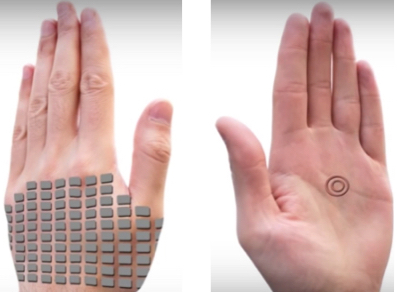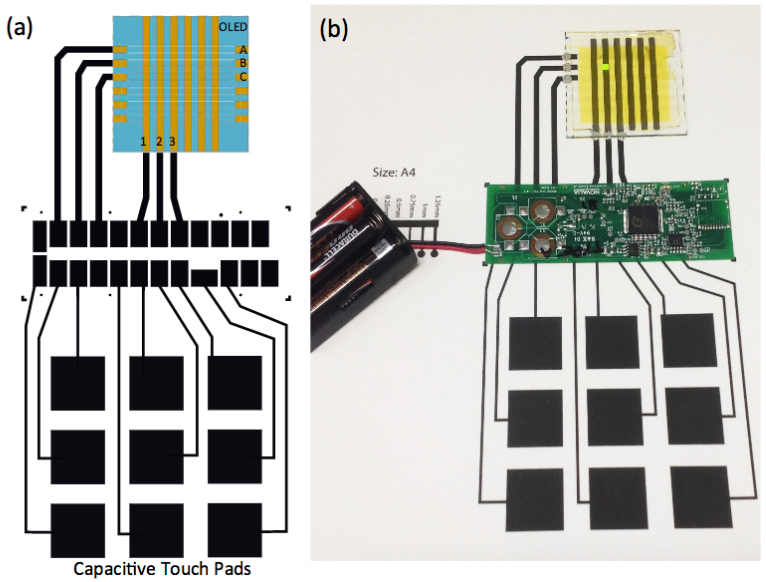Turning hands and packages into displays
April 15, 2016

The SkinHaptics device sends ultrasound waves through the hand, focused at a precise point on the palm. (credit: Sri Subramanian / University of Sussex)
Imagine using your hand as an interactive touch-screen display. Sounds like science fiction, but Nokia Research Centre and the European Research Council have funded a study, led by the University of Sussex, to develop such a device, which could be used as a display for the next generation of smartwatches and other smart devices.
Called SkinHaptics, the device (still in the lab) sends ultrasonic pulses to your palm from the back of your hand, creating tactile sensations (similar to the iPhone 6s and Apple Watch “3D Touch” feature, which senses the amount of pressure your finger applies to the screen and can trigger various actions).

SkinHaptics ultrasound transmitter (left) and display (right) (credit: University of Sussex)
SkinHaptics is based on haptics, the science of applying touch sensation and control to interaction with computers and technology. It uses “time-reversal” processing, make the waves converge and become more targeted as they travel through the hand (rather than being dispersed), and ending at a precise point on the palm.
Professor Sriram Subramanian, who leads the research team at the University of Sussex, says technologies will need to engage other senses, such as touch, as we enter what designers are calling an “eye-free” age of technology. “If you imagine you are on your bike and want to change the volume control on your smartwatch, the interaction space on the watch is very small. So companies are looking at how to extend this space to the hand of the user.”
The findings were presented at the IEEE Haptics Symposium 2016 in Philadelphia.
Interact Lab | SkinHaptics: Ultrasound Focused in the Hand Creates Tactile Sensations
Package displays
In another innovative display concept, scientists at the University of Sheffield and technology company Novalia have developed technology for affixing an interactive display to packaging to display a promotion or an instructional label, for example.
This technology could be used in greetings cards or on products that allow a customer to receive a simple message or even ask questions.

(a) Schematic of the capacitive touch-pad array, electrical circuit and LED array. (b) Photo of the integrated electronic system on the printed paper substrate. (credit: University of Sheffield)
In a paper published in the IEEE Journal of Display Technology, the team explains that the process involves printing electronic tracks onto paper, using a low-cost conductive graphite ink, to create capacitive touch pads and then affixing low-cost CMOS electronics and a polymer LED display to the paper, using an adhesive that conducts electricity.
The scientists also designed and constructed a touch-pad keyboard on paper that allows a user to selectively turn LEDs in the display on or off. The process could potentially be printed on other surfaces.
The research has been funded by the Engineering and Physical Sciences Research Council (EPSRC).
Abstract of SkinHaptics: Ultrasound Focused in the Hand Creates Tactile Sensations
Recent developments in on-body interfaces have extended the interaction space of physical devices to the skin of our hands. While these interfaces can easily project graphical elements on the bare hand, they cannot give tactile feedback. Here we present a technology that could help to expand the output capability of on-body interfaces to provide tactile feedback without restricting the skin as an interaction surface. SkinHaptics works by focusing ultrasound in the hand using a phased array of ultrasound transmitters and the acoustic time reversal signal processing technique. We present experimental results that show that this device can steer and focus ultrasound on the skin through the hand, which provides the basis for the envisioned technology. We then present results of a study that show that the focused energy can create sensations that are perceived under the skin and in the hand. We demonstrate the potential of SkinHaptics and discuss how our proof-of-concept device can be scaled beyond the prototype.
Abstract of Polymer Light Emitting Diodes Powered via Paper-mounted Electronics
We have interfaced an array of polymer light emitting diodes (OLEDs) fabricated onto a glass substrate to a sheet of paper via a pressure sensitive conducting adhesive. By screen-printing a series of capacitive touch pads and connecting tracks onto paper using a low-cost conductive graphite ink, we are able to drive individual pixels in the OLED array via CMOS-based electronics that are also attached to the paper. Three AA batteries are used to power the CMOS electronics, touch-pads and the OLED array, with pixels in the array operating at a brightness of up to 210 cd/m2. The work highlights a practical interface between plastic- and paper-based electronics.